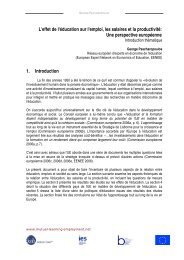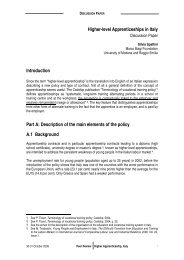The Active Labour Market Policy Reform – The Second Wave
The Active Labour Market Policy Reform – The Second Wave
The Active Labour Market Policy Reform – The Second Wave
You also want an ePaper? Increase the reach of your titles
YUMPU automatically turns print PDFs into web optimized ePapers that Google loves.
May 13-14, 2004<br />
EXECUTIVE SUMMARY<br />
General discussions of transferability issues<br />
<strong>The</strong> Peer Review on the second wave of active labour market policy reforms in Finland<br />
stimulated a lot of interest on the part of a large number of European countries, many of<br />
which are undergoing reforms themselves. <strong>The</strong> emphasis in all countries has been on a shift<br />
from passive to active measures and on a change in the benefits system. <strong>The</strong> Danish expert<br />
pointed out in his paper that, like Finland, most countries introduced the reforms in two<br />
stages: a first stage with massive investment in active labour market measures and<br />
expanding the existing framework of measures and a second stage reforming the framework<br />
of measures. Many countries are following a similar route to Finland in ‘joining up’ services<br />
(PES and social security services in particular). <strong>The</strong>re is an effort to provide the client with a<br />
comprehensive offer epitomised in the one-stop-shop. As a result of the similarities in<br />
developments across Europe, the discussions were able to focus on concrete details of the<br />
reforms. <strong>The</strong> issue of what to do with the hard-to-reach end of the labour market was<br />
discussed at length, perhaps at the cost of other aspects of the reforms, and experts and<br />
officials were very interested in the LAFOS. While the dual approach was considered<br />
effective in dealing with the multiple problems of the hard-to-place, the question of its impact<br />
on employers and their perception of the different groups of unemployed was raised. This is<br />
an issue and must be carefully treated in order not to impose a stigma on those who are<br />
already in a weak position on the labour market. <strong>The</strong> question of how to classify the<br />
unemployed was also discussed.<br />
Due to the current state of reforms in the peer countries present or to their economic<br />
situation, it was felt that the transfer of the Finnish policies would be difficult. For the new<br />
member states in particular, the Finnish solutions were often not considered transferable due<br />
to a lack of funding, infrastructure, IT technology and trained staff.<br />
However, a number of aspects, particularly relating to the establishment of e-services, were<br />
considered potentially transferable in the long run.<br />
A further aspect that was discussed was the difficulty of evaluating such programmes and<br />
what would constitute relevant benchmarks. This is an important aspect of the Peer Review<br />
methodology and a theme that is being addressed by different projects within the European<br />
Employment Strategy 7 .<br />
7 <strong>The</strong> EMCO Indicators Group is working on this issue and so, for example, is the ‘Performance Indicators for<br />
Public Employment Services’ project co financed by DG EMPL and the Austrian PES (AMS). Consultants to the<br />
project are ÖSB Consulting and Synthesis Forschung and the results of the project will be available at the end of<br />
2004.<br />
Peer Review <strong>The</strong> <strong>Active</strong> <strong>Labour</strong> <strong>Market</strong> <strong>Policy</strong> <strong>Reform</strong> <strong>–</strong><br />
<strong>The</strong> <strong>Second</strong> <strong>Wave</strong><br />
16





